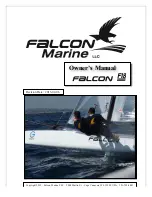
Section 3
3-2
GENERAL SAFETY
The popularity of boating and other water sports has undergone an explosion of
growth in the past few years, making safety an important issue for everyone who
shares in the use of our waterways.
WARNING!
Read and understand this Operator’s Manual, the Engine
Operator’s Manual and all manufacturer-supplied information regarding the
operation of equipment. As a boat owner, you must understand all safety
information responsibilities, regulations, controls and operating
instructions before attempting to operate your boat. Improper operation can
be extremely dangerous and/or fatal.
The safety content and precautions listed in this manual and on the boat are not
all-inclusive. If a procedure, method, tool or part is not specifically recommended,
you must feel confident that it is safe for you and others, and that your boat will not
be damaged or become unsafe as a result of your decision. REMEMBER –
ALWAYS USE COMMON SENSE WHEN BOATING!
As a boat owner, you are responsible for your own safety, as well as that of your
passengers and other boaters.
GOOD BOATING PRACTICES
Boating-related accidents are generally caused by the operator’s failure to follow
basic safety rules or written precautions. Most accidents can be avoided if the
operator is completely familiar with the boat and its operation and can recognize
potentially hazardous situations.
In addition to everyday safety, failure to observe safety recommendations may
result in severe personal injury or death to you or to others. Use caution and
common sense when operating your boat. Do not take unnecessary chances!
Failure to adhere to these warnings may result in severe injury or death to you
and/or others.
Read this entire manual and be aware of other specific safety guidelines not listed
below. Seek additional safety information from the USCG, state and local
authorities. In addition to specific safety statements noted in this manual, a
general list of safety guidelines and recommendations is listed below:
• Your boat must comply with USCG safety equipment regulations.
• Before each outing, check all safety equipment such as fire extinguishers, life
jackets, flares, distress flags, flashlights and engine stop switch. Be sure all
safety equipment is operable, in good condition, readily visible and easily
accessed.
• On-board equipment must always conform to the governing federal, state and
local regulations.
Copyright 2019
Ken Cook Co.
All Rights Reserved
www.KenCook.com/marine
Содержание Fi21
Страница 1: ...Centurion_Cover_2019_Layout 1 10 24 2018 9 48 AM Page 1...
Страница 3: ...This Page Intentionally Left Blank...
Страница 7: ...iv This Page Intentionally Left Blank...
Страница 17: ...Section 1 1 10 This Page Intentionally Left Blank...
Страница 27: ...Section 2 2 10 This Page Intentionally Left Blank...
Страница 48: ...Safety 3 21 Figure 3 4 Figure 3 4 CNTRN 0050B A...
Страница 68: ...Safety 3 41 Figure 3 10Centurion Ri237 Figure 3 13 Figure 3 11Centurion Ri217 Figure 3 14...
Страница 69: ...Section 3 3 42 Figure 3 12Centurion Fi25 Figure 3 15 Figure 3 13Centurion Fi23 Figure 3 16...
Страница 70: ...Safety 3 43 Figure 3 14Centurion Fi21 Figure 3 17...
Страница 71: ...Section 3 3 44 This Page Intentionally Left Blank...
Страница 130: ...Controls Features and Options 8 23 Ri Ballast Tank Locations Figure 8 20 Fi25 Ballast Tank Locations Figure 8 21...
Страница 131: ...Section 8 8 24 Fi23 Ballast Tank Locations Figure 8 22 Fi21 Ballast Tank Locations Figure 8 23...
Страница 165: ...Section 10 10 10 This Page Intentionally Left Blank...
Страница 192: ...Notes C o p y r i g h t 2 0 1 9 K e n C o o k C o A l l R i g h t s R e s e r v e d w w w K e n C o o k c o m m a r...
Страница 193: ...Notes C o p y r i g h t 2 0 1 9 K e n C o o k C o A l l R i g h t s R e s e r v e d w w w K e n C o o k c o m m a r...
















































